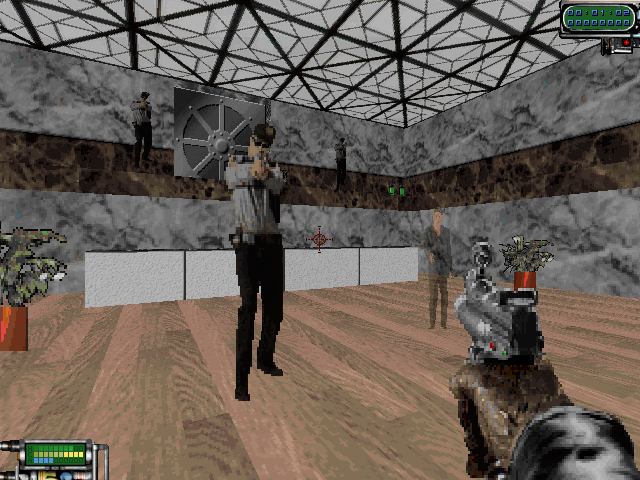


Konami's The Simpsons arcade game features the Noiseland Video Arcade in the background of the Springfield street in the first stage, but the Simpsons don't enter it. The machines are actually dangerous, though, as enemies pick up the cabinets and toss them at the hero. Only a few show the title of the game stored here, a garbled font apparently saying Sly Spy, another game by Data East. All bear the Data East logo, but most are turned to the side or back. The titular mechanized law enforcer in Robocop 2 for arcades walks through an area that looks like a storehouse for arcade machines. But even though the title is unreadable, it is obviously a three-player Beast Busters cabinet, with its three SMG design lightguns on the control panel. The early Neo Geo brawler Burning Fight features a nameless machine right in the beginning. You still only walk by the entrance here and cannot see too much of it.

The first and possibly the most obscure example of visible arcade machines in this category, Target Renegade is one of the semi-inofficial sequels of Technōs' Renegade published by European licensee Ocean. Arcade machines were an efficient antidote - some interesting titles on the cabinet are enough to let the player's imagination do all the work for you - except many of these examples don't even bother with titles.Īn early example of an arcade walk-by can be found already in Sega's proto beat-em-up My Hero, which feature's the arcade "Game" with a very American sign font but only from the outside. Gang-busting adventures in urban areas were still a quasi standard setting for beat-em-ups far into the 1990s, but it's not that easy to come up with a lot of graphical variations between levels if every other game takes place in a modern day city. Computers and consoles on which games can be played do not count either, although we've got a little surprise in that regard at the end. Also not included are retro releases and other games that are framed within an arcade-themed border themselves. Note that this is not a list simply of minigame interludes - only where these games are framed as within arcade cabinets, they become eligible for this list. This is a collection of all the various ways games have incorporated arcade machines in their worlds, from single cabinets as background decoration to fully functional game centers. But even if they are not actually playable, it is strangely meta to see game hardware or screen displays in a game. The idea to have an experience for which you had to go to a special place about twenty years ago not only in your home, but in a game you're playing in your home is just stunning. This is especially true for arcade games, which in the past had always been the "big brother" of home entertainment. There is something very intriguing about the idea of video games within video games - the sense that games have become so advanced in simulating worlds that they started simulating themselves inside of those worlds.


 0 kommentar(er)
0 kommentar(er)
